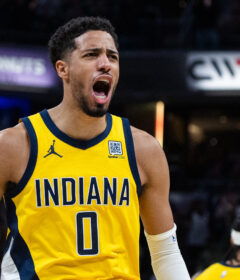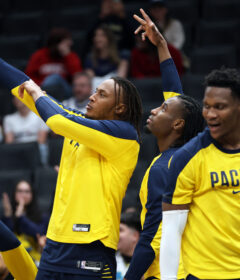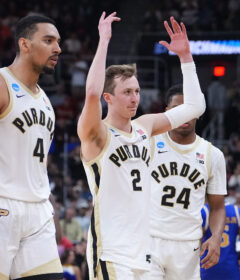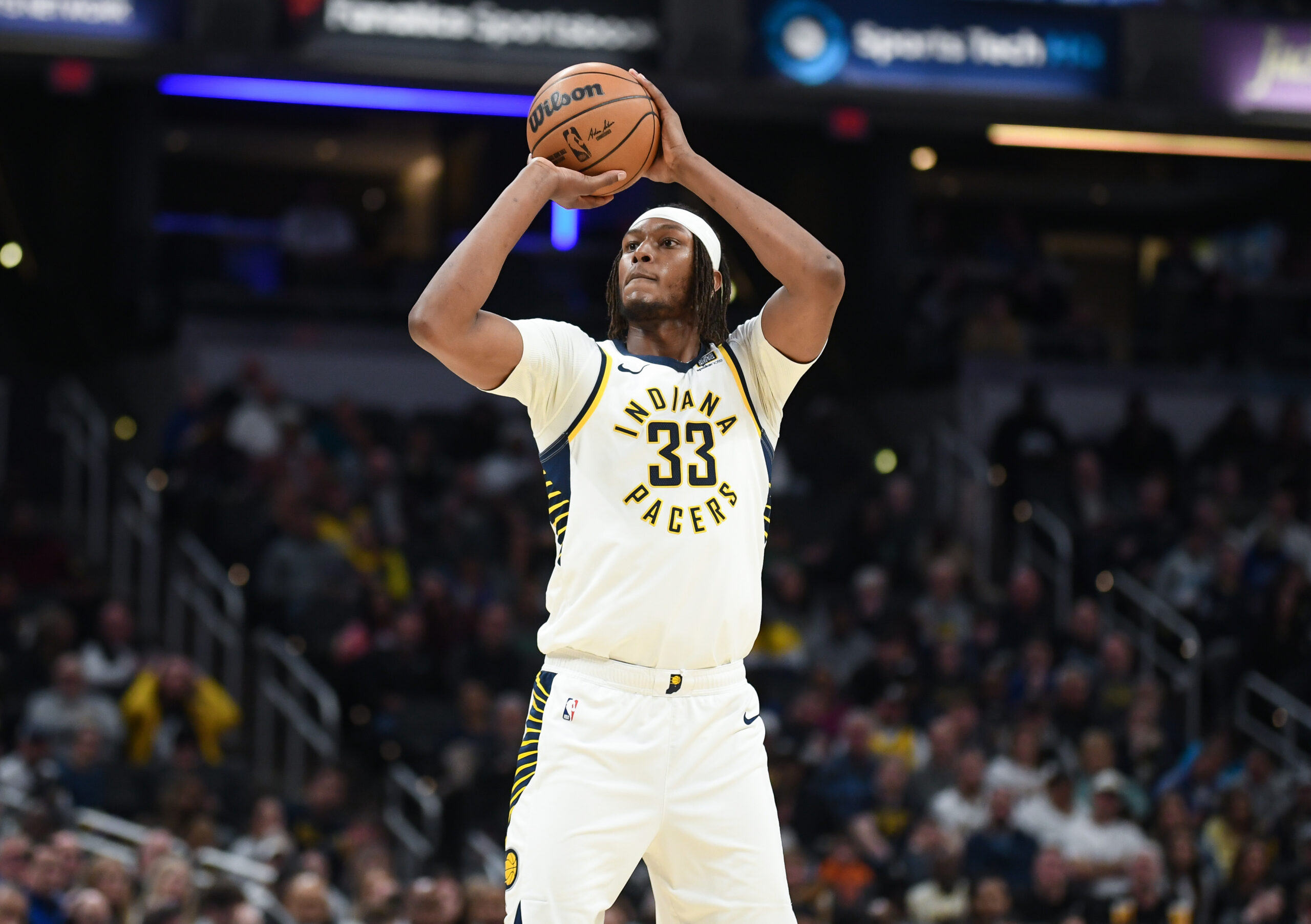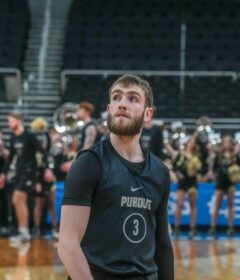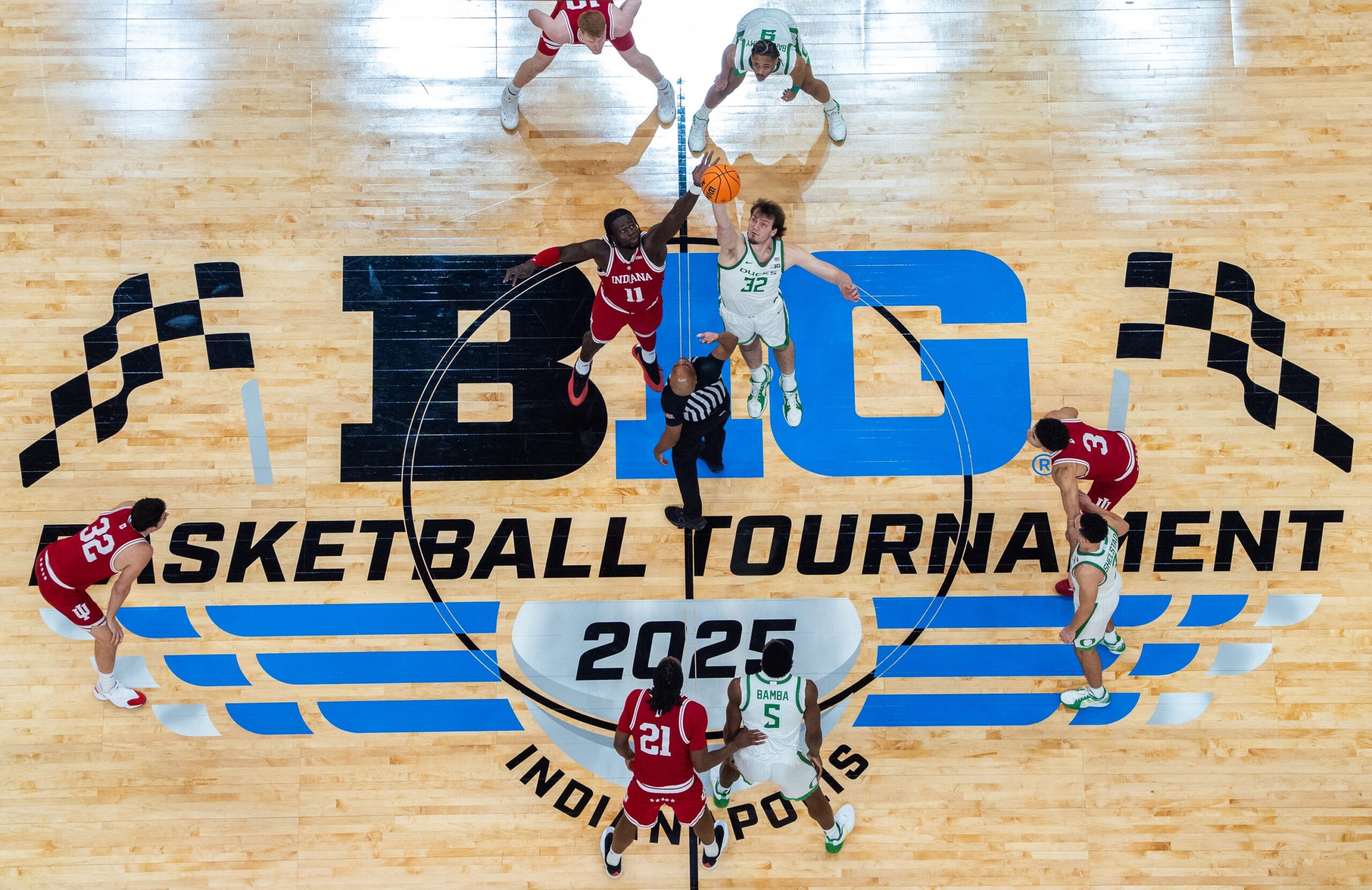In-season review: evaluating Butler player-by-player

 By CHRIS GOFF
By CHRIS GOFF
ISL Correspondent
As Butler prepares for what coach Brad Stevens terms the “reward” for a long season — the month of March — the time is ripe for an assessment of each player’s strengths and weaknesses. Enough games have been played for trends to solidify, and the statistical readings have mostly shaken free of flukes and outliers. Before March Madness begins, you need the ultimate scouting report on the Bulldogs. It’s right here. All 14 players. Dig in.
ROTNEI CLARKE, PG
Stats: 17.0 ppg, 2.8 apg
Clarke is an awesome shooter, so all discussion starts there. He is second in the Atlantic 10, and first among guards, in effective field goal percentage. He is shooting 43.3 percent on 3s, good for second in the league, while taking nearly two-thirds of his attempts from out there and shooting a sizzling 88.1 percent from the line. A gunner with a quick release even off the bounce, Clarke has unlimited range and an indefinite green light. Not surprisingly, he is Butler’s best per-minute scorer; only six players in the A-10 are ahead of him.
Despite that brilliant marksmanship, Clarke’s true shooting percentage is merely decent. He just doesn’t get to the rim or the charity stripe enough. His 2-point shooting percentage (38.3) is poor. Butler will live with that. Their senior transfer has cured a scoring-starved roster. Clarke is a suspect defender. He hardly ever steals the ball, and he has blocked one shot in his last 1,816 minutes of game action. Again, small potatoes.
An interesting note is that Clarke has struggled at the point, especially dribbling against pressing defenders. Obviously once he gets the ball across midcourt he looks mainly to score. No beef there. The trouble is he’s so mistake prone, ranking ahead of only eight A-10 point guards in turnover ratio. The most condemning stat is Clarke’s pure point rating, which at -3.18 is very bad for a lead guard on a contending team. Initiating an offense isn’t his thing, and Clarke, who is not a great distributor, would be a full-time shooting guard but for this arrangement of necessity. So the switch hasn’t worked, but Clarke is good enough otherwise to make you forget it.
ANDREW SMITH, C
Stats: 11.2 ppg, 5.6 rpg, 0.7 bpg
Here’s how good Smith is: Using advanced stats, he’s probably been the best player on the team. Clearly his defensive efforts are of critical importance, and associate head coach Matthew Graves has said Smith’s size alone clogs the lane to the detriment of opposing offenses. His value could be seen immediately when an injury kept him out of the Charlotte game. He may not have great quickness or leaping, but the 6-foot-11 senior anchors the back end.
Smith is fourth among A-10 centers in points per minute and ninth in offensive rebound rate. That’s the tip of the iceberg. He is eighth in the conference, and third among centers, in player efficiency rating, and he also ranks sixth in the league in true shooting percentage. Between a deceptive ball fake and a relentless crashing of the offensive glass, Smith has the highest free throw rate of anybody in the conference. He makes them, too, converting 72 percent at the line, second-best at his position. Additionally, Smith has a very high assist ratio for a center. Whether passing out of a double or handling in the high post, Smith is adept, leading A-10 centers in pure point rating. This is the stuff stars are made of.
A decline in 3-point percentage has been offset by a better shot mix and more frequent trips to the line. Even with Rotnei Clarke, Butler has been no less reluctant to call Smith’s number. He is a tough low-post scoring threat who likes to shoot hooks from the left block and is averaging 16.8 points per 40 minutes.
ROOSEVELT JONES, SF
Stats: 10.6 ppg, 5.8 rpg, 3.4 apg
Jones has become a master of creating points from 4 to 10 feet, an area of the floor in which most players struggle to hit shots. Short runners and floaters are Jones’ specialty, and that skill shone at the last second against Gonzaga. Jones has grown into a huge factor in Butler’s offense. He is scoring more than expected – 14.4 points per 40 minutes, up more than three points from last season – and is without a doubt the team’s best distributor. As a freshman he played more away from the ball, but Jones now ranks fourth on the team in pure point rating and is dishing out a team-high 4.6 assists per 40 minutes. His assist rate is No. 11 in the conference and ranks second among A-10 forwards and centers. He’s become very good at setting up interior looks in particular, and now uses his driving ability to make a pass rather than just to get his own shot.
Not only can Jones orchestrate the attack on one end, but he is a stopper on the other. The Bulldogs often use him on the opponent’s best scorer, and he can readily handle the gig, as long as the assignment isn’t a dynamic guard with excessive quickness. He truly is an excellent defender, possessing the strength to check power forwards and the mobility to play some guards, too. Jones still manages to ferociously compete on the defensive glass, where he is fourth among A-10 small forwards in rebound rate. Hampered by an injured shoulder since early February, Jones has been gutting it out with the help of protective padding. Toughness and effort warrant praise.
The one thing you’d like to see more of is Jones protecting the ball. Of course, Jones is a very poor outside shooter, but does not attempt jumpers, so the point is moot. At 56 percent, Jones is a terrible foul shooter, but there’s little hope he might be able to turn things around, and the coaching staff keeps him on the floor at the end of tight games anyway. Jones is unorthodox, and some fail to appreciate that, but he has been a revelation this season.
KHYLE MARSHALL, PF
Stats: 9.8 ppg, 4.7 rpg
Marshall may not be an ideal power forward because he’s undersized at 6-foot-6, but he moves well without the ball into openings and excels on alley-oop plays. He is an extremely valuable offensive player because he creates shots (7.5 attempts per game, third-most on the team) and converts at a high rate (55 percent, tied for fourth in the Atlantic 10) with virtually no cost in turnovers. Marshall has miscues on only 10.2 percent of his possessions this season. Also, though he hits only 56.9 percent at the foul line, he does draw fouls.
Nonetheless, Marshall has not made a huge jump in his junior year, and while his talent has always enticed, the results have not delivered in a correlative manner. To fuel the naysayers, Marshall decided to post the exact same numbers he did last season. Sure, there are some small variations if you look hard enough – his player efficiency rating is down nearly two points – but the bigger picture is that Marshall has shown a disturbingly flat development curve. It’s not simply a product of Butler adding more weapons, either. Despite additional punch in the backcourt, Marshall’s usage rate has not fallen considerably. One hang-up is that, outside of the dunk, he lacks a go-to move. Adding a post game would help immensely, but he hasn’t taken a step forward in that department.
Marshall is a high character guy, and he has admitted to letting times of struggle affect him mentally. To go far in March, the Bulldogs need Marshall to put forth consistent production.
ALEX BARLOW, G
Stats: 2.2 ppg, 2.7 rpg, 2.0 apg
Barlow can’t score, but at his absolute best, he can help the offense as a distributor. Though he isn’t quite a true point guard, he has offered some benefit to Rotnei Clarke as an additional dribbler in the starting lineup. More of a baseball player than hardwood warrior in high school, Barlow struggles to get to the basket. He is hitting 65 percent of his 2s (13 of 20) but he shoots so infrequently that he averages only 4.6 points per 40 minutes.
Butler knew Barlow could defend, and he still has. Although undersized for a shooting guard, Barlow guards with great intensity and moves his feet well. Without the advantage of experience, he has done well and has time as a junior and senior to get even better. As an athlete, he is average at best, and his foot speed is lacking. Yet Barlow has a nose for the ball and always seems to wind up in the right spots. His rebounding numbers – 5.6 per 40 minutes – are outstanding for a small guard. Most incredible is his knack for thievery. Barlow leads the team and is in the top 10 of the conference in steal rate.
Unfortunately, Barlow is far too turnover-prone, which offsets the steals. His turnover ratio of 37.6 is worst in the A-10, and only 20 players in Division 1 give the ball away more frequently when they are on the court. Ball pressure and traps give Barlow all kinds of trouble. If he can’t hang onto the ball and make better decisions, the coaching staff will have to reconsider whether he’s a viable starter.
KELLEN DUNHAM, G
Stats: 10.6 ppg, 2.9 rpg
Dunham continues to be very effective in his sixth man role, and at 19, there’s the potential for more. After a slow start this season Dunham has been a different player in conference action. The freshman displayed just 29.8 percent 3-point shooting before the turn of the calendar, but is at a scorching 42.5 percent since then. The truth is likely shaded more toward the latter figure, considering Dunham is an 88.2 percent marksman at the line. There are signs that Dunham still must adjust to the college game: He is shooting only 47 percent on 2s, has a very poor rebound rate for someone garnering NBA whispers and hasn’t created much for teammates. But the upshot is that, as a jump shooter, he has a very low turnover ratio, lowest among Butler’s regulars, in fact. Also notable is that Dunham has been crafty enough to draw fouls at a decent clip; his free throw rate is third-best on the team. Saint Louis coach Jim Crews recently lauded Dunham’s awesome shot fake and effective footwork.
At 6-foot-6, he’s large for a shooting guard and probably should move to small forward, though that position is capably occupied by Roosevelt Jones at the moment. Dunham has seen minutes at the 3 when Jones is on the bench. Dunham is averaging 15.8 points per 40 minutes – fourth on the team – despite a low usage rate. He uses only 19.4 percent of Butler’s possessions per 40 minutes, a rate more in line with a minor contributor than a big scorer like Dunham. This makes Dunham a highly efficient offensive player, as he leaves lots of other chances for his teammates to score, too. Because he makes 3s, draws fouls and nails the freebies, his true shooting percentage is 59.3, fifth in the Atlantic 10.
ERIK FROMM, F/C
Stats: 3.6 ppg, 2.9 rpg
Fromm has good size but no post game and takes more than half of his shots from beyond the arc. Not surprisingly, his field-goal percentage isn’t much to work with and his free throw rate is low. But that hasn’t stopped Fromm from contributing. Fromm is third among A-10 centers in offensive rebound rate, which is especially impressive for someone who spends so much time working from the high post and setting screens. He has a double-digit PER for the first time in three seasons at Butler. As a pick-and-pop guy, he does need to shoot more accurately. Fromm is making just 30.2 percent of his 3-pointers. Perhaps a late-season streak is in order if last year’s 34 percent mark is indicative.
Defensively, Fromm is average at best overall. He aims for a mistake-free approach and does not try to block shots. Fromm tends to rack up fouls, as his rate of one every six minutes is extremely high. If he played the full 40 minutes, Fromm would foul out – on average – with 10 minutes left in the game.
Butler isn’t counting on Fromm as more than a backup center, and it’s a role he can handle adequately. Fromm has battled a bad back in the past but appears healthy. Keep in mind, this is the guy whose 2012-13 season has included the declining health and eventual death of his father, so talking about anything basketball is a tenuous exercise.
KAMERON WOODS, F/C
Stats: 3.8 ppg, 4.4 rpg
The slender Woods is prone to being overpowered underneath, but he is as reliable defensively as any big man outside of Smith. Woods had played mostly at center for Butler, but lately he’s been getting minutes at power forward, and his defensive aptitude at either spot is of real value. He’s 6-foot-9 and mobile. Woods’ playing time is down from last season, but that is a product of Erik Fromm’s growth rather than any decline on the part of Woods.
Woods is 10th in rebound rate among all A-10 performers, and he ranks fourth in steal rate among players his height. Meanwhile, Butler outscores opponents by 1.7 points with Woods in the game, nearly a full point and a half better than with Fromm. Woods can help fellow defenders with his ability to comfortably switch on guards and contain them. He can also block shots, although his block rate is oddly down from 7.6 to 3.4.
We already knew Woods was strong on defense, but his progress on offense this season has been a pleasant surprise. Woods is chipping in 9.4 points per 40 minutes with respectable efficiency, and although his jumper remains erratic, Woods has adjusted by feeding in the basket area, posting a 54.5 percent mark from the field, including some highlight dunks, up from 37.0 a season ago.
CHASE STIGALL, G
Stats: 2.1 ppg, 1.5 rpg, 0.9 apg
Stigall’s 29.4 percent mark on 3s is especially painful given that his main role is to space the floor and that almost all his shots are 3s. But it’s not like he should just move inside the arc; dude is shooting 34.1 percent on 2s in his Butler career. This season has added a new problem. Stigall now has an unacceptably high turnover ratio for a shooter who virtually never attacks the paint and who never creates his own shot.
Nonetheless, this is not a totally lost season for Stigall. His seven points against Gonzaga were pivotal in one of Butler’s most important wins, his six points at Dayton helped replace Rotnei Clarke, and his 12 points against St. Bonaventure allowed him to sit in front of reporters at the postgame news conference. Defensively the senior is still pretty effective. He knows what he’s doing. He’s tough. He’s smart and has a great attitude. He’s rebounding reasonably well.
Stigall’s offensive instincts are nearly all geared toward scoring. He’s a marginal player, and, between the feeble shooting and sudden rash of mistakes, it’s becoming increasingly difficult to justify giving him regular playing time. In the last nine games, Stigall’s playing time has exceeded nine minutes just three times.
JACKSON ALDRIDGE, PG
Stats: 1.0 ppg, 0.8 rpg, 0.8 apg in 21 appearances
Aldridge has not gotten traction in his career at Butler. He has been a bad shooter – he’s making 25 percent on 3s and 32 percent on 2s. Yet the truly eye-popping stat is the high turnover ratio – it was 28.0 as a freshman and is up to 29.5 this season. That type of brutal ballhandling won’t cut it. A point guard cannot make mistakes on more than one-fourth of the possessions he uses. So in spite of Chrishawn Hopkins being kicked off the team and Chris Harrison-Docks deciding at the last minute to transfer, Aldridge is still lost in the crowd. He just doesn’t bring much to the table while managing to knock off some of the plates and silverware. That’s a crippling combination.
DEVONTAE MORGAN, G
Stats: 0.9 ppg, 0.2 rpg in 15 appearances
Minutes have not opened up for Morgan this season. He is just a freshman, so there’s plenty of time for him to impact the program. He is a potential stopper – at least, Stevens thinks so. He is a definite pogo stick, as evidenced by that lob he jammed home with one hand against IUPUI in November. Part of Morgan’s potential hinges on his position. Can he handle the ball well enough to play point guard? As a wing, does he provide enough outside shooting? He is athletic and long but with a currently thin frame.
ANDREW SMEATHERS, G
Stats: 0.8 ppg, 0.4 rpg in 17 appearances
Smeathers is tall for his position (6-foot-6) but can’t play the frontcourt because he lacks the lateral quickness and strength to defend against power forwards. He can space the floor. When Butler snuck him into games against Gonzaga and Charlotte for short, meaningful stints, Smeathers did not deliver. That’s a problem because Smeathers must be at least adequate as a three-to-four-minute stopgap. For his career, Smeathers has taken 57 3s and only 11 2s. Thanks to all the jumpers he doesn’t get to the foul line. It’s fair to wonder if he’ll ever be a rotation player.
ELLIOTT KAMPEN, G
Stats: 0.0 ppg, 0.2 rpg in 10 appearances
A scorer in high school, Kampen joined his brother, Emerson, on the team last season after spending his freshman year of college at Indiana University and away from basketball. His decision to walk on at Butler proved a good one for both sides. At 6-foot-5, he is big for a college wing, and he can shoot a little bit. It’s difficult to justify playing him because he would struggle to defend athletic players.
EMERSON KAMPEN, C
Stats: 0.1 ppg, 0.2 rpg in 14 appearances
The taller, elder Kampen has scored two points all season, and those came against IUPUI. He is not a great athlete. Since he has barely played, he has not had much opportunity to develop. An undersized center, Kampen’s main role these days is to throw long inbounds passes, almost like a long snapper in football who perfects an underpublicized task.
Short of a run of injuries, Kampen has no chance of moving into any role beyond that, but he’s a good teammate, and coaches love having that at the end of the bench.

